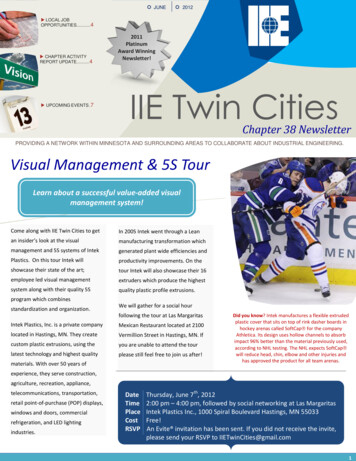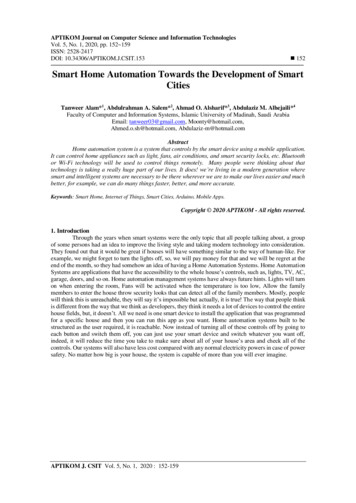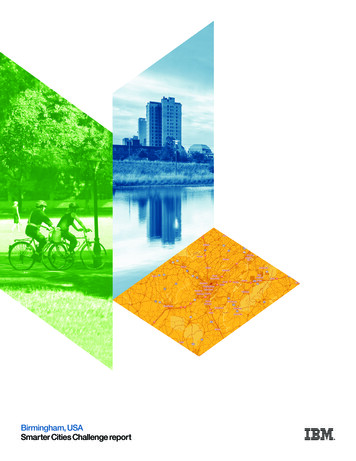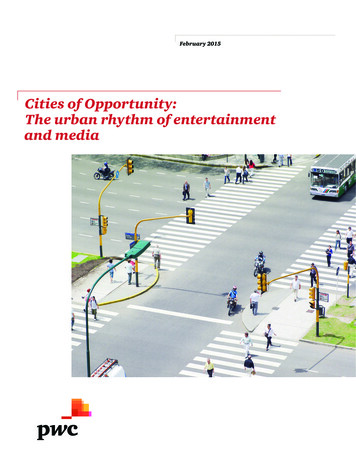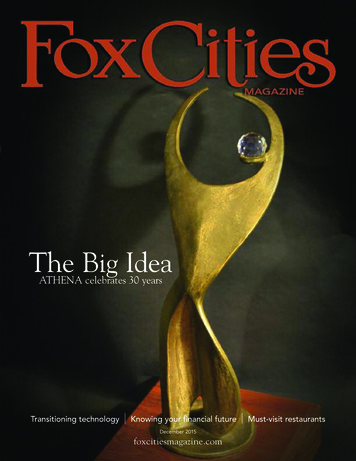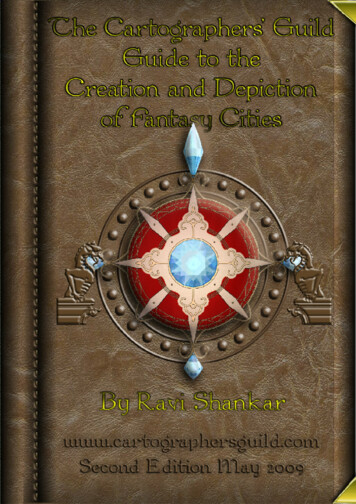
Transcription
The Building of Cities is one of man’s greatest achievements. The form of his city has been and always willbe a pitiless indicator of the state of his civilisation. This form is determined by the multiplicity of decisionsmade by the people who live in it.Edmund Bacon-Design of CitiesThis guide is an explanation of how to build and map an imaginary city in a low technology or fantasy setting.City construction and depiction are not separate processes: your city will almost certainly require a sketch atan early stage to assist in the process of visualisation, this in turn encourages ideas about design elements, suchas architecture, inhabitants, economic and social boundaries. Alternating between textual and visual descriptions is a good way to work as it helps to ensure an internal consistency between the tangible and intangibleelements of your city.The twin primary objectives of any fantasy city builder should be to give the city a distinct personality and tomake it memorable. The degree to which a city is credible, that is, logically feasible, is a matter of degree to bejudged by its designer with an eye on the expectations of his or her audience. Cities that are too credible runthe risk of wasting the designer’s time in creating elements which the audience will not see or appreciate andworse, there is a risk that the city might appear pedestrian because of real the world strictures placed upon it.On the other hand, overly unbelievable cities destroy the suspension of disbelief which is required for anyfantasy world to successfully exist. Generally audiences are forgiving and designers can depart from credibilityso long as the city fulfils the twin objectives. If in doubt, opt for personality over realism, a 200 metre high stonecolossus standing astride a river may be a physically impossible feat, but this is fantasy after all and thedesigner will receive more credit for a grand idea which stimulates the imagination than by ensuring that thereare enough market places to support a population density of 200 people to an acre. One only has to recall thegreat cities in fantasy literature, such as Khazad-Dum in JRR Tolkien’s ‘Lord of the Rings’, to remember thatits vast and intricate underground chambers were so majestic and enthralling, worries about how such a darkplace could produce enough food to support a population of thousands of Dwarfs never materialised in thereader’s mind.That said, making a memorable city, particularly one which is populated by humans, involves a number ofprocesses which encourage the reader to readily believe that people could live there. This involves (among otherfactors) giving the city a sense of history and architecture consistent with its environment (you would not expectto see Bedouin tents in Arctic tundra any more than you would igloos in the desert) and above all an instinctivefeel that this is a place that has been shaped with a particular purpose in mind by the hands that built it – the‘pitiless indicator of the state of civilisation’ that Bacon mentions above. So making a memorable city means thatthe designer will need to know at least the basics of urban design in real life, particularly that of older cultures.As we shall see, reference material on how and on what principles cities of antiquity were built can beimmensely valuable.To be memorable, a city should avoid cliché, which means that it needs to possess at least some originality. Infantasy RPGs cliché is often the norm, (and expected in many cases). The processes I describe are intended topromote more original cities but of course they can be used to produce ‘standard fantasy fare’ if required whichwill involve less creative thinking.One does not have to follow the processes described in this guide in any particular sequence and none of theprocesses are written in stone. They are intended to be starting points from which a fantasy city can take shapeand grow in a more or less balanced way. The designer should feel free to add his own methods and sequencesso that the design experience is comfortable and natural. Creators of new processes are encouraged to post themat the Cartographers’ Guild: www.thecartographersguild.com together with any comments that they wish toleave for the author.This guide will be published in parts. Part I being a discussion of some general principles to city building. Overtime I will almost certainly come back to previous parts and amend them. Further parts and new editions tothis guide may be found at the Cartographers’ Guild at the website address mentioned above.Ravi Shankar, August 2008The Creation and Depiction of Fantasy Cities2
c
Describing Personality.Authors and RPG creators almost always have the aim of evoking an emotional response from their readers, soit is only natural that their cities should work in step with this aim. The first question in the process shouldtherefore be: What emotions should my city evoke? Wonder? Menace? Comfort? Bustle? Tranquillity? Differentparts of a single city might evoke contrary emotions, nevertheless try to keep in mind an overriding emotionalresponse or two for the entire city.As a preliminary exercise, think about the great cities of the world both past and present and try to describethem in sensory terms – sight, hearing, touch, smell and taste. For example, how does Casablanca in Moroccocompare with Lhasa in Tibet? The chances are that you have never been to either of these places (I haven’t) butyou have perhaps read about them or seen themin films. It does not really matter what they areExample 1really like, what is important is how you feelabout them and what emotional responses theyIn my constructed sword and sorcery world, I have placed a city onprovoke in you. From describing these places ina mountainous northern coastline with a with high cliffs droppingsensory terms it is an easy step to arrive at andown to the sea. I have determined that the area has bitterly coldemotional response.winters and temperate summers and is inhabited by humans whohunt a particular type of large sea creature which they trade in thesouth.For example, when I think of Casablanca I thinkof busy bazaars, narrow streets, poor urchins,For my own reasons (perhaps related to the RPG’s or novel’s plot)rich merchants, unintelligible gabbling languages, a claustrophobia from the press of people, I want the city to have an emotional response which is insular,threatening, arrogant and proud of past (and lost) glory.ever present noise, low standards of hygiene inpublic places, dust, a sudden boundary to openIt would be very easy to immediately seize upon some adaptation ofdesert, a cacophony of different smells, little ora Viking race, (northerly climate, sea-farers, possibly warlike) butno wind and rain and a stifling heat.let us try to be more imaginative than that.When I think of Lhasa, I think of a huge dominating palace over a low rise, stepped city of uniformstone buildings, wide streets, crisp thin air, asense of peace and solitude, a simple but spiritual people, incredible sunrises and sunsets andpanoramic mountains on a majestic scale.Summing up Casablanca in emotional terms Imight arrive with the following: Dangerous,crowded, chaotic, oppressive, hot. And with Lhasa: Peaceful, ordered, intolerant of change, cold.These words describe the personality of the city.As I did with Casablanca and Lhasa, might jot down the followinglist of sensory input: Huge crenulated ships pulled by some manner of sea beast (threatening), a walled city with few entrances(unfriendly), made of dark stone (threatening), perched on a cliff(dominating/arrogant). Small cramped buildings (unfriendly andeasy to heat in the cold), few public spaces (unfriendly), ornate,high crumbling towers and a courtly language (faded glory), public displays of weapons (threatening), few or no inns for strangersto stay in (unfriendly). A loud horn in one of the towers to guideships home in the fog (domination by sound), a martial culture(threatening).When I approach the design of the city I will have foremost in my mind these personality traits and I will try toabide by them. If a city’s dominant climate is cold, I might choose to map it in whites or blues. If hot, in orangesor reds. Of course, following the personality traits too slavishly will result in caricatures or cardboard cut-outs,but as your city develops using the other tools and methodsmentioned later, your city should grow a sufficient patina ofExample 2complexity to ensure that it is not seen by the reader asoverly two-dimensional. When designing a fantasy city, youLet us suppose that I want my city to have the samegeographical location as in example 1, but I want it toare unlikely to have any but the most rudimentary sensoryhave an entirely different emotional response: friendfeel of the place; perhaps a notion of the climate, topography,ly, hardy, simple and strong.the race of inhabitants who live there and basic politics. Itis therefore often best to start with the emotional conclusionNow the following images come to mind: light coland from that extrapolate the sensory data from which theoured buildings widely spaced with large windows,details will emerge.gardens and greenery (perhaps a pine-forest with openpastures and alpine flowers), lots of public space(perhaps a village green or public square), a busydockyard with sailors mending nets, few if any weapons on show and a large tavern at which locals mixwith strangers.The Creation and Depiction of Fantasy Cities4
A splatter diagram is an excellent tool to begin the detailing of your city. As you fill out your splatter diagram you will begin toget a much better idea of fundamental elements and their relationships with each other. Making the splatter diagram is perhapsthe most intensive and fun part of the process of city building. Here is how I go about it.First, get away from the computer; all you need is a pen and paper. Find a quiet place and picture yourself standing at the gatesof your new city. Think carefully and try to feel the emotional descriptions mentioned the last chapter. In your mind’s eye, thinkabout everything that you can see. In your mind’s ear, talk to the city natives. Wander through the city streets. Who do you meet?What are their day to day problems? Where do their loyalties lie? Where do they live? Who are their enemies and friends? Whoare their family? What sorts of events are taking place around you? A street brawl? A magnificent pageant? By having imaginaryconversations with them, think about what languages they speak, and what they wear, whether they are rich or poor, where theylive and what they eat and drink. Jump into their characters and become them. Live a day in their lives. See where they go andwhat they do. Now you are familiar with the people, look at the buildings . How high are they? What are they made of? Are theyplain or ornate? Clean or dirty? How narrow or wide are the streets? Is the landscape flat or sloped? Are there any dominatingfeatures like rivers or mountains?The old adage ‘A picture is worth a thousand words’ is very appropriate here. The sharper and more complete your mental imageof your city, the easier it will be to detail. Start with the vague emotions you arrived at when outlining the personality of your cityand work out from there. What are the most important buildings which dominate the City? Who owns them? Who works or livesin them? Do they reflect the character of the people who live there and the emotive feel you want the city to convey. Each answeryou get to your questions gives you a better idea of what your city should look like. I find that I can get the best mental images ofmy city when I’m lying in bed before I fall asleep. I then put down my ideas on the splatter diagram on my way to work in themornings. From this mental role playing you can very quickly construct and alter your city to fit the emotive personality you wantit to have. Each idea breeds new hooks for other ideas.On the next page is a splatter diagram I made for the city of Arborea (pictured left). The background to this map is that it was foruse in the the Cartographers’ World BuildingProject, a communityproject to build a fantasyworld. The emotive feel ofthe map was of a manmade stone structure imposing itself on a forestenvironment. It would be awalled city keeping out theunnamed fears that stalkedhidden in the surroundingwoodland. The stone contrasts strongly with the natural landscape and thenearby necropolis gives avisual reason for the fearswhich created the walls. Inretrospect the woods looktoo ‘friendly’ I shouldhave made them darker toemphasise the feel of keeping out the nameless fear.Politically, the city is divided into wards, the higherthe ward, the fewer andlarger the buildings, reflecting greater wealth. AsI built the city, it occurredto me that the model of aTuscan walled city wouldbe perfect for the job. So Iwent onto the Internet andfound a map of the city ofMontepulciano which Iadapted for the purpose.Fig 1The Creation and Depiction of Fantasy Cities5
Fig 2The Creation and Depiction of Fantasy Cities6
In order to stamp your city with character it is worth looking at city archetypes. An Archetype gives animmediate understanding of the function of the city and says something about its politics and people. Here arethree examples:Fig 3In the first example the buildings are constructed upon a rectilinear grid system, around a centre of importance(the circle). We know the circle is more important because it differs and thus stands out from the other shapes.This type of design suggests strong central planning. It suggests that the city was built all at once and that thepeople who live in it had no say about where buildings were placed and a dominance over the underlyinglandscape. Perhaps it was a new city, built by an emperor or perhaps some sort of Romanesque fortification,ordered to be built by a general. In either case it has been planned and we know that it represents anauthoritarian society. Grid systems do not have to be rectilinear; any repeated regular pattern will eventuallyform a grid of sorts. After linear grids, Radial grid cities are most common in real life.The second example shows streets with curves, suggesting some resonance with the underlying landscape whichdetermine human movement - the easiest way to walk from A to B with the least possible effort is to follow acontour. Some of the streets are straight which suggest central planning. Note that all the streets are of thesame width. Here is a city which suggests some central authority but which is built more in harmony with itssurroundings and people. Perhaps the authority followed the main existing roads of an unplanned city andimposed some new ones of its own.In the third example are streets are of varying width, their pattern are like veins on a leaf . This is a city whichhas evolved over time and through a process of accretion. There are still public spaces of importance, forexample, the circular negative space stands out. Perhaps this city was once built using formal rules but overtime the citizens of the city have encroached into public spaces making them their own with regard to only theirlocal concerns and not some overarching order. Note that the network of streets in the north east corner aremore intricate than in the south west. This suggests that the north east is perhaps older and less ordered thanthe south west, where ad-hoc building has been forbidden by authority. This city map has a sense of of historyabout it. The width, shape and directions of the streets follow no predictable pattern, but they look like theyhave evolved. A pattern to the streets might become more apparent once more facts are known, for example theunderlying landscape, a physical calamity or the locations of centres of commerce.Fantasy cities, in order to underline their character and personality to aid in story telling, often follow,archetypes more closely than cities in reality. Minas Tirith from the Lord of the Rings is ordered and centrallyplanned, reinforcing the emotive feel that this is a city on a war footing and which is run by a strong centralauthority. On the other hand in the world of Robert E Howard’s Conan, cities are more muddled affairs, oftenwith political power in a constant state of flux. Disputes between factions break the city up into neighbourhoodsover which individuals or groups extended varying degrees of influence. A city in Conan’s world would not havesat easily in Middle Earth or vice-versa. Always bear in mind the three archetypes when building a fantasy city. A single city may incorporate all three (typically the wealthy areas would be ordered and the less wealthy areaswould be more organic). Having a warren of tiny streets to represent poor areas is an often used visualshorthand but it does not necessarily follow that all poor areas should be unplanned and all wealthy areasplanned. Think of your city’s personality and which archetype best suits it.The Creation and Depiction of Fantasy Cities7
The heart of the city was probably the fortifiedIsland in the centre of the river.The city has been meticulously planned. Longthoroughfares lead to important buildings andmonuments.Fig 4The radial and linear grid system adopted bythe city planners is evident, but is broken upby the canal system which follows a curvingroute.The streets follow an organic pattern. The suggestion is that the city is crowded and much ofthe building is ad-hoc.The streets on the northern part of the city follow the contours of the hill. Ribbon development is taking place along the river bank.Fig 5Note the lack of public space. Only importantbuildings and monuments have a clear areaaround them.Fig 6The gradual transformation of a gridded Roman colony into an Islamic city. Left: The solidly framedRoman grid is punctuated by an open-air market and an amphitheatre. Centre: The city’s newIslamic population appropriates these public monuments for private use, and mid-block pathwaysbegin to violate the orthogonal street pattern. Right: The transformed city is one with a minimum ofopen public space. Straight passages along the winding system of narrow lanes offer the merestsuggestion of the original layout.The Creation and Depiction of Fantasy Cities8
Generally speaking, cities are located at sites which meet one or more of the following criteria:Ÿ Strategic or defensibleŸ Easily available to tradeŸ Close to a source of fresh waterŸ Close to a source of food.This is why many cities are generally to be found at river estuaries. They are in a position to control trafficmoving up river and close to a water source. Alluvial soil is generally fertile which makes for good crop yieldsand pastureland. Maritime Trade communications are aided by the city’s proximity to the sea. London andNew York are examples of such cities. On the other hand, Paris and Madrid are located near the centre ofFrance and Spain. At a time when order was imposed by large armies and foreign invasions were relativelycommon, the central positioning of capital cities meant less time for armies to move to trouble spots and greater security from invasions.Below is a randomly generated Fractal Terrains map on which I have placed a number of cities together withexplanations for their locations. When placing cities on a fantasy map, many factors will come into play, including political boundaries and historical events. Wherever you place your city, make sure that there is agood historical reason for putting it there. Also make sure that the environment works with the personality ofthe city. Remember that you can always adjust the environment to justify your city placement by, for example, drawing in a river or adding a trade-route. The key is to ensure that your city’s location fits effortlesslyinto the story that you wish to tell.The location of your city will have a knock-on effect on your city’s design. Cities located in mountainous areasare likely to be built to withstand the weather. Owing to its abundance, stone is likely to be the building material used. Similarly, cities built near forests are likely to be constructed of wood which will be abundant and iseasier to work.FertileNatural harbour & riverControl over the shortestroute across the mountains.DefensibleGood river communications inlandFig 7The Creation and Depiction of Fantasy Cities9
As previously mentioned, one factor governing the shape and placement of the elements of a city is the amountof central planning involved in its construction. Another equally important factor is the environment in whichthe city is built, in particular the topography of the landscape, the climate and the presence or absence ofexternal threats. In the world of fantasy, cities have been built in places not replicated in the real world, forexample underground, in trees and floating in the sky. What follows are some thoughts as to how topographydetermines the general shape of cities in real life, from which it is hoped that the designer can extract principlesfor use in imaginary cities.Settlements that are built along rivers have some fairly typical features. Initially they are long and thin, following the river’s course on one or both banks. Thecentre of the settlement is usually an area of commerce, like a marketplace ordocks. As the settlement grows into a city, it will tend to take a rounder shape(assuming no topographical obstacles such as mountains) as the inhabitants willprefer to be closer to the commercial centre rather than the riverside. Virtuallyall riverine settlements will have roads that run along the river banks. Theseare likely to be the oldest roads in the city.Fig 8Fig 9Natural harbours often form gentle curves at the base of a topographical bowlwhich meets the sea. If there is a slope down to the sea, which is often the case,it is common for streets to follow its contour lines. Any settlements are usuallycrescent shaped with the main area of activity at or near the dockside. If thereis a steep slope down to the harbour, then access to the settlement is usually bya single road, passing through the town with habitations built along the line ofthe road. There is generally more construction at the base of the slope wherethere is flatter land to build on and which also acts as the commercial centre.Defensive cities are the staple bread and butter of Fantasy RPGs perhaps the most famous example being ‘TheKeep on the Borderlands’. In reality, walled defences were common in Medieval European and Asian citieswhere the threat of invasion was a reality, the advent of blitzkrieg tactics and superior artillery made thedefensive walls redundant by the FirstWorld War. Because of the importance ofwalled cities in fantasy novels and games, abrief study of city defensive fortifications isdealt with as a separate chapter later inthis work. Walled cities do not,as a rulefollow a typical shape. Living conditionsinside walled cities tend to be crowded withmost of the citizens living in apartmentsand only the very wealthy in houses. Sometimes the city outgrows its walls resultingin a new bounding wall enclosing the old,rather like the rings in the cross section of atree. Walled cities use topographical features to enhance defence. In the above mapof Antwerp, the river Schelde acts as a moatalong one edge. The fortified hill towns inTuscany were a daunting prospect to besiege, being set upon hill tops and withdefensive fortifications besides.Fig 10The Creation and Depiction of Fantasy Cities10
Hilltop and linear ridge cities often find their roots as defensivepositions. Typical features of such cities are a limited number of entrypoints (which are often heavily fortified) and often dominance over ageographical means of communication, typically a road, river, bay ormountain pass. Often such cities started as fortresses or castleswhich expanded over time. Roads and defensive design tended tofollow contours, so in the case of linear ridge cities the shape of thecity is elongated following the spine of the ridge. With a hilltop citythe shape is more rounded. Hilltop and linear ridge cities are amongthe most dramatic cities built, one only has to visit the Alhambra inSpain or any number of hilltop cities in Northern Italy to understandwhy. It is for this reason that fantasy cities are often of this type their dramatic position makes them memorable.Fig 12Cities built on hills and Fig 11ridges often depended onobtaining their food from the lowlands. Some hill cities inthe built in the middle-east had large underground storage tanks or cellars for water. The walls of the city provided a safe refuge and a rallying point in times of war tothose living in the lowlands. These cities were a statementof political dominance. Hilltop cities rarely evolve by accretion of smaller settlements, they are usually constructedunder the command of a feudal lord.Without the advantages of piped, running water from distantplaces deserts are not suited to urban life in low technology societies, so cities located in deserts should be few and very far between.The size of the city would almost certainly be related to the amountof available water (presumably from an oasis) and food with theindividual or group controlling the water source being the mostpolitically or religiously powerful. In a fantasy world of course therules are more flexible. Vast cities rising out of the open desertmake for dramatic settings. Access to underground reservoirs filledby a subterranean river and the presence of a city on a well pliedcaravan route might provide the food and water justifications for alarger city. In terms of shape, as the topography of a deep desert isgenerally flat, the city is likely to develop around centres of commerce and along arterial routes, as shown in the adjacent map ofmodern Timbuktu. Although Timbuktu is built on flat terrain,mountains are not uncommon in the desert and would provide asource of security and perhaps some protection from sandstorms.Fig 13When building fantasy cities, the imagination should not be overly restrictedby what is possible in real life. Cities can exist within the trunks and on theboughs of tall forests, or as deep underground complexes. While no real lifehistorical counterparts of such cities exist, think of the principles applied toreal cities and apply them to imaginary situation of your city. Ask lots ofquestions - who are the inhabitants? Is there a need for defence? If so fromwhom or what? What is the most effective form of defence available by usinglocal materials? Above all think generally how the topography affects yourcity’s shape and plan your city accordingly. By taking into account the shapeof the land (or whatever medium your city is built on) your city should acquirea feel that your city is working in harmony with the medium on which it is built.Fig 14The Creation and Depiction of Fantasy Cities11
For a city to look harmonious, its structure should should possess both axes and rhythm. The axes provide themain lines of movement or importance and the rhythm is determined by or determines the size, shape andlocations of its focal points. In the map to the left, of the StormlitCloister, a number of axes radiate from the alcove in the Grand Hall,suggesting that the Grand Hall is the most important building in thecomplex and that the alcove is the most important point in the GrandHall.StormlitCloisterThe distribution of the buildings around the Main Hall roughly follows a Fibonacci spiral (one of the most pleasing geometric forms tothe human eye used by countless architects in the past, present anddoubtless future) giving the building distribution a sense of rhythm.In this case the axes are used to suggest importance by leading theeye to a central point. The distribution of buildings leads the eye in aspiral which again is centred on the focal point of the complex.If the intention is to disturb the harmony, (let us say for example, theStormlit Cloister had been invaded by destructive -and visually tasteless - Orcs), then it is a simple matter of placing (or destroying)buildings which interrupt the natural rhythm and appear jarring tothe eye. Of course such geometry is only readily apparent with abird’s eye view; one which would be impossible to the normal cityFig 15 inhabitant. Nevertheless, the principle is important if the aim todesign a city which is centrally planned or pleasing in geometricalterms. Axis and rhythm apply to cities as much as they do to smaller settlements as the drawings belowdemonstrate. When designing a city, think about where the main axes lie (usually along an important road) andthe points that you will use to define the axes (important buildings, public spaces, grand arches or statues allserve this purpose).In his book,Edmund Bacon identifies six ‘connectors’ which relate spaces and structures.Fig 16.1. Althoughthe structures do not follow any form of planning, theangular spaces between them provide the relationship.Negative space in cities normally indicates roads, markets and other open spaces. It is these which bind thebuildings together.Fig 16.4. During the medieval period, cities often grewaround rectangular spaces. In this example the overlap between the two rectangles is cleared and towersare built on the areas indicated in grey, increasingthe importance of the junction of the two yellow spaces.Fig 16.2The use of axes at right angles to each other indicates a love of order, orsome form of tyranny. Here the axes and buildings closely interlock with each other, creatingthe effect of a large buildings composed of smaller discrete ones.Fig 16.5Here we see axes created bycity landmarks. Invariably these would be roadsof importance which would lead from one important building or space to another. This is thebackbone of order established in cities which otherwise grow by accretion. Central planning takesplace in a limited areas only.The
rich merchants, unintelligible gabbling languag-es, a claustrophobia from the press of people, ever present noise, low standards of hygiene in public places, dust, a sudden boundary to open desert, a cacophony of different smells, little or no wind and rain and a stifling heat. When I think
